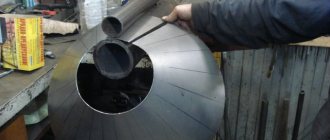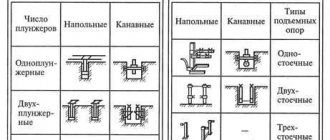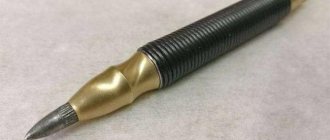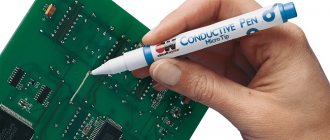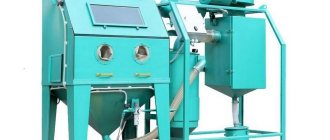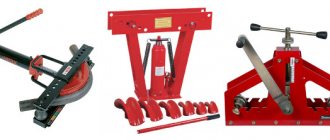The device of a mechanical punch In addition to manual punches for creating holes (cores), there are also automatic punches - “crossbows” with a cocking-trigger and spring mechanism.
The design of a mechanical tool is based on the tight compression of a spring built inside and its subsequent release. Among automatic punches, the most common are manual mechanical ones, which allow you to apply markings with one hand. Most of them use the Sweet mechanism, patented back in 1942.
The operating principle of a mechanical center punch with the Sweet mechanism.
The working cycle of the mechanism of this automatic device includes three stages:
- The sharp end of the rod is installed according to the markings. At this time, the pusher, due to the shape of the front surface of its cap, is in a slightly skewed state and rests its upper end against the edge of the striker. When the body is moved downwards by manual force, the working spring is compressed.
- At the top point, when the spring is fully compressed, the pusher moves from a lateral to an axial position, occupying a place directly opposite the recess in the striker. This is a key feature of this automatic mechanism, for which its inventor received a patent.
- The upper part of the pusher passes into a recess in the striker, the spring is free to move and transmits the accumulated impulse through the striker and pusher to the pointed rod. Since the body of the automatic center punch continues to be held by the mechanic’s hand, all the kinetic energy of the striker will be directed toward breaking through the core hole.
After punching is completed, the device is removed from the surface and the return spring sets the pusher to its original skewed position.
Tags: automatic center punch
Comments 19
Damaged drill bit from a hammer drill
It’s normal, depending on what you hammer, the hardened one will sit quickly
Our driller would erase all his fingers like that. There is nothing better than a core from a milling cutter or a tap, which you need to hit with a regular hammer.
The diesel injector needle is even better
We have a lot of taps and cutters XD
No doubt about it)) we don’t have many needles, but I managed to get three of them from the fuel man)) real Amer’s Caterpillars.
The title throws you off at the very beginning. Incredibly annoying. I didn't even look. No likes, no reposts, no subscriptions.
The name is for those who know why the videos are called that.
This irrepressible energy must be directed in the right direction.
Of course, I understand everything, but why saw with a grinder when you have a lathe, and the threads can be cut there too... But regarding the efficiency of this craft, I agree with the comments below. And such a product is not expensive ru.aliexpress.com/item/1-…l?ws_ab_test=searchweb0_0, searchweb201602_5_10152_10151_10065_10344_10068_10342_10343_10340_10341_10543_10084_10083_106 18_10307_10301_5711220_5722320_10313_10059_10534_100031_10103_10624_520_10623_10622_10621_10620_10142_10125, searchweb201603_36, ppcSwitch_ 7&algo_expid=b0337761-3bb0-4c89-b89a-4e8ed823df12-3&algo_pvid=b0337761-3bb0-4c89-b89a- 4e8ed823df12&priceBeautifyAB=0
Of course, I understand everything, but why saw with a grinder when you have a lathe, and the threads can be cut there too... But regarding the efficiency of this craft, I agree with the comments below. And such a product is not expensive ru.aliexpress.com/item/1-…l?ws_ab_test=searchweb0_0, searchweb201602_5_10152_10151_10065_10344_10068_10342_10343_10340_10341_10543_10084_10083_106 18_10307_10301_5711220_5722320_10313_10059_10534_100031_10103_10624_520_10623_10622_10621_10620_10142_10125, searchweb201603_36, ppcSwitch_ 7&algo_expid=b0337761-3bb0-4c89-b89a-4e8ed823df12-3&algo_pvid=b0337761-3bb0-4c89-b89a- 4e8ed823df12&priceBeautifyAB=0
If I'm not mistaken, the student does not support standard threads! 0.8; 1 and 1.2
I think the knob that is directly on the core should be reduced in mass and the impact one should be increased, so the impact force will be stronger due to the increase in the mass of the impactor. And yes, it’s not a bad thing to need news))
Why complicate life so much, it’s easier with a hammer, you can hit weaker, you can hit harder
Convenience and efficiency are questionable (ratio of impact mass to accelerated mass) en.wikipedia.org/wiki/Aut…h_operation_animation.gif
There’s an automatic lying around, we bought it for 150 rubles or something. You hold it like a pen, press down and it slaps, punches.
Source
Do-it-yourself automatic center punch
Any metalworking operation is preceded by marking the part with lines and reference points deepened into the surface of the metal. The first ones are done with scribers, and for applying the second ones there is a special marking tool - a center punch. In general form, it is a small metal cylinder with a sharpened working end and a flat back.
GOST punches are made of rolled rods of alloy and carbon tool steels. In conventional punches, the marking point (core) is applied by hitting a hammer, while in mechanical automatic punches a spring and a striker are used for these purposes.
This tool has a more complex design, but is highly accurate and allows you to work with one hand. In addition to spring ones, there are automatic electric and pneumatic punching devices. They are much more expensive than conventional and mechanical punches, so they are used in industrial production with large volumes of marking work.
A specialized tool for applying cores allows automatic alignment on similar parts or cylindrical surfaces.
Benefits of the tool
Judging by the reviews of the owners of such products, the spring automatic center punch has the following advantages:
- Marking is done with one hand: no percussion instrument is used.
- The master has the opportunity to control the force of impact with a cone-shaped rod on a metal surface. This feature, which the automatic mechanical punch has, allows you to safely process soft and fragile materials without the risk of damaging them: the same depth is a characteristic feature of all holes made by this tool.
- The marking procedure with a mechanical center punch is much faster than with a standard one.
Functions and purposes of the core
The geometric and operational characteristics of conventional punches are regulated by GOST 7213-72, and the automatic tool is manufactured according to the specifications and internal documentation of individual enterprises. The main purpose of the center punch is to create indelible marks on the surface of the workpiece and recesses in the metal for precise insertion of the drill.
In both cases, core punching is carried out along pre-applied marking lines. When there are a large number of core points, it is preferable to use an automatic tool, since this significantly increases labor productivity and reduces the likelihood of errors due to fatigue of the mechanic.
When making parts with the same hole pattern, one of them is usually used as a template. It is placed on the next workpiece along the marks, fixed with a clamp, and then a core mark is applied to the workpiece using a transfer punch (see figure below).
Automatic centering of the marks on the surface of the workpiece occurs due to the uniform support of the cone on the surface of the hole of the template part.
In addition to marking, punching is also used to lock (prevent unwinding) threaded connections. To do this, place one to three core holes in the gap between the threads of the screw and the nut or along the edges of the slot of a countersunk screw.
The deformation of the metal that occurs upon impact is sufficient for locking, but allows the threaded connection to be unscrewed using a conventional tool. In mass production, it is better to perform this operation with an automatic tool.
Another area of use for center punches is impact-point marking. Coding of parts is mandatory for their subsequent processing and identification in assembly production.
Usually, specialized pneumatic and electric machines are used for this, but for single production in small volumes, it is quite possible to get by with an automatic mechanical punch.
Tool classification
The center punch is designed to create small conical recesses on the metal surface using a pointed end, which, in accordance with GOST, must be sharpened at an angle of 60÷90º.
The principle of operation of all punching tools is the same: the tip is deepened into the marked material by striking the rear end of the rod, and the force applied depends on the hardness of the workpiece.
The main differences between individual types of punches are the methods of striking and holding the rod in a given position. First of all, a distinction is made between conventional manual and automatic punches.
The latter, in turn, are divided into mechanical devices with manual drive and installations with pneumatic and electric hammers. In addition to devices for punching with manual holding of the rod in the required position, tools are produced with automatic installation of the tip in the desired location and at a given angle.
This includes transferable and self-centering punches. In addition, there are a number of devices for punching, supplemented with special equipment (magnifying glasses, compasses, etc.). Devices for impact-point marking, which are essentially automatic punches for special purposes, are usually classified into a separate group.
Manual punch
Unlike an automatic marking tool, which is a prefabricated product, a conventional manual punch is a monolithic metal rod and consists of four functional parts (see figure below):
Depending on the operating conditions, various protective and decorative coatings can be applied to the outer surface of the product. In the simplest case, this is ordinary blackening, and for work in special conditions, chromium coatings are used over an underlayer of nickel and cadmium-plated chromium.
Automatic center punch
Among automatic punches, the most common are manual mechanical ones, which allow you to apply markings with one hand.
Most of them use a Sweet mechanism with an intermediate pusher, and only high-force industrial models use other types of mechanisms without pushers.
The body of a typical automatic mechanical punch consists of three parts (see figure below). This design was chosen solely for the convenience of its manufacture, as well as assembly and disassembly of the tool.
What to make a core from
If among professionals anyone called this tool a core, it ceased to be such by definition. A core or core is a hole in the material - the result of the work of the punch and nothing else.
And also a sample of soil rock obtained in a special way, but this is definitely not the subject of our article.
Now, even Wikipedia presents the word “kern” as the second name for the instrument - puncher, which is fundamentally wrong, but let’s leave this to the conscience of the authors of the material.
Kerner - what is it?
The center punch is a metal rod made of tool steel with a sharpened striking part, sharpened at an angle of predominantly 120° and hardened to a length of 20 - 30 mm, and a striker on the other side, also heat-treated, but 10 - 15 mm. It is also called the butt plate. Used in metalworking to obtain holes or cores necessary for the convenience of drilling material.
Most of the tool remains unhardened, and therefore less fragile, which is done primarily for the purpose of safety of its use.
The cross-sectional shape of the punch rod does not play a special role: it can be round, and then it is often knurled to make it more convenient to hold it in the hand, or maybe hexagonal.
The material of the hexagons is carbon steel, amenable to heat treatment, therefore, if you need to quickly make a center punch at home and find a hexagon with a suitable cross-section, you can safely use it - it will accept hardening without carburization (saturation of the surface layer of steel with carbon).
Punching, in almost all cases, is carried out for subsequent drilling of the material, so that the drill does not slide along the surface of the workpiece at the initial stage of drilling. But there are also options...
Depending on the diameter of the drill, the dimensions of the punch are also selected, but this more often happens in production during mass punching to produce holes of different diameters.
Also, the sharpening angle of the punch may be different, because for soft metals the drill is sharpened at a smaller angle.
Techniques for working with a center punch
There are only two ways of punching: one is correct, the second is incorrect.
For core you need:
That's all, failure to follow these rules will lead to a violation of the accuracy of the core or the shape of the hole, which may cause the drill to move away.
If you made a mistake when punching, then do what no plumbing textbook will advise you to do:
Types of center punches - photos
In addition to the manual version of this tool, there are other varieties of it.
How to restore chrome plating
The factor of obvious increase in the speed of core punching is also important.
4. In an electric punch, an induction coil retracts a spring-loaded firing pin. Everything else is very similar to the mechanical version of the instrument.
How to make a punch with your own hands
For those who do not want to pay 300 - 500 hard-earned rubles for a center punch of more or less normal quality, there are several options for making this tool on your own. We have already mentioned the first one - from a hexagon.
And this can be done even on a regular gas stove, heating the metal until it glows bright pink.
Although it is much faster to do this with a gas torch or a gasoline blowtorch, which, we hope, you already have in your workshop.
You can also quickly make a primitive, but quite workable center punch from an old drill whose side edges have lost their functionality, and therefore cannot be sharpened, by simply sharpening its end.
However, we still do not recommend using such a tool in its pure form - it is very fragile and can break upon impact and cause injury. As a last resort, put a piece of high-pressure hose on it, as in the version in the photo, but better - select a metal sleeve from a tube of suitable diameter or grind it.
In addition to the options mentioned, there is a way to make a center punch from almost any steel, but only carbon steel can be hardened. If you are not sure about the carbon content in it, then you can check this by sparking when processed on a grindstone. And here is the video:
And if you did not see the long-awaited stars when sharpening a suitable rod for making a center punch, then you can carry out the cementation process, which we mentioned at the beginning of the article. There are two ways to do this at home. If you have a welding machine on your farm, then the one shown in the video is the most acceptable and simple.
And if purchasing a welding machine is still in your plans, then look for a nearby metalworking plant where they sharpen cast iron parts and collect cast iron shavings, the smaller the better.
Or buy cast iron powder online. Having heated the metal to the same bright pink glow, lower the part of the workpiece that needs to be quenched into cast iron shavings. The carbon from the cast iron will move into the surface layer of your mild steel and allow it to harden.
The procedure can be repeated several times, but sharpen the center punch before it. However, the instrument can be repaired in the future in the same way.
Required tools and materials
If the metal is sufficiently hard, a drill or self-tapping screw screwed in with a screwdriver can easily slide off the intended point, and in such a situation a large scratch or even a broken drill cannot be avoided. To prevent this from happening, it is customary to make holes or cores, and there is a special tool for this - a center punch!
Penciler - what kind of tool?
The capper is a completely simple device - a steel rod from 100 to 160 mm in length, with a diameter of 8-12 mm.
The process of making a metal scriber
Holding the bolt in a vice, cut off the head and most of the threads.
We insert the bolt shaft into the chuck of the drilling machine, turn it on and use a grinder to round the end formed after removing the head.
We turn the bolt over and form a cone in place of the remaining thread and dull its tip.
We correct the cone with a file and make two belts on the rod to make it easier to hold the tool with your fingers in the future. We finally form the other end.
We clamp a drill (broken) made of HSS steel with a diameter of 3 mm in the drill chuck and form the working part in the form of a sharp cone. The tip can also be made of silicon carbide or tungsten.
We tap the blunt cone of the bolt and drill an axial hole with a diameter of 3+ mm and a depth of about 25 mm.
Squeeze a drop of superglue into it and insert a pointed drill with the fastening part.
The scriber is completely ready to work on both soft metal and steel.
Mark. We drill where we need to!
A conventional core tool consists of one piece - a strong steel rod. This can be U8 steel, hardened to 65 HRG and tempered. Chrome-vanadium alloy or other durable types are used. One end is sharpened in the form of a cone, the other is flat. The rod itself can be seven-sided or round. The length of the center punch ranges from 10 to 16 cm, thickness - 0.8-1.2 cm.
The process of marking cores (holes for installing a drill) goes like this. Hold it with your left hand. The sharp end of the tool is placed at the location of the intended hole.
This word should not be confused with the concept in geology, where it refers to rock obtained by drilling.
There is no point in sharpening the core with emery, since its material cannot be processed in such a way.
Application
Using a core, you can make marks on any surface. It is advisable to use it when working with smooth materials. These are tiles, polished surfaces. Most often it is used when drilling metal. Therefore, core samples are often referred to as metalworking tools.
Masons also actively use it. Special mason cores have been created for this purpose. They are not much different from locksmiths. They are often powder coated in a bright color to make them easier to find if lost.
A core is also used to make the processing lines visible. To do this, the applied markings are passed through with frequent cores, making it dotted.
What are they?
Automatic center punch allows you to:
Automatic core allows you to make up to 50 shots per minute with a distance of 2 cm between holes.
Instead of a core tip, you can insert a stamp into the rod and brand the parts.
An automatic (mechanical) core looks a bit like a metal fountain pen. It consists of two chambers, each of which has its own firing pin. The first one is made in the form of a cut cone. There is a striker there, which will apply cores to the surface. Behind it is a spring-loaded striker with a guide rod. Its spring is slightly offset to the side.
Behind it, inside the housing, there is a through hole. In the second chamber there is a piston with a beveled edge, spring-loaded by a powerful spring.
When the tool is placed on the surface and the thrust cap is pressed with the thumb of the right hand, the striking pin rests against the edge of the spring-loaded piston, lifting it. The spring behind it compresses and creates counter pressure.
At the end of the compression process, centering and alignment occurs towards the primary chamber. This leads to the rod breaking off and falling sharply into the hole.
The spring pressure is transmitted to the firing pin through intermediate elements. It hits the surface of the material, and a hole from the automatic center punch remains on it.
In some models, the lower striker can be changed, thus extending the service life of the tool.
The process of making a metal scriber
Holding the bolt in a vice, cut off the head and most of the threads.
We insert the bolt shaft into the chuck of the drilling machine, turn it on and use a grinder to round the end formed after removing the head.
We turn the bolt over and form a cone in place of the remaining thread and dull its tip.
We correct the cone with a file and make two belts on the rod to make it easier to hold the tool with your fingers in the future. We finally form the other end.
We clamp a drill (broken) made of HSS steel with a diameter of 3 mm in the drill chuck and form the working part in the form of a sharp cone. The tip can also be made of silicon carbide or tungsten.
We tap the blunt cone of the bolt and drill an axial hole with a diameter of 3+ mm and a depth of about 25 mm.
Squeeze a drop of superglue into it and insert a pointed drill with the fastening part.
The scriber is completely ready to work on both soft metal and steel.
Do-it-yourself automatic center punch: principle of operation and device
When working with metal, a craftsman often has to drill holes. During this procedure, the drill bit often slips to the sides, thereby creating great inconvenience. This can be prevented by using a device such as an automatic center punch.
Standard
A regular center punch is a metalworking tool made in the form of a handle equipped with a rod, for the manufacture of which special tool steel is used. The purpose of the center punch is to make small indentations in the surface of the metal into which the tip of a drill bit for a hand or electric drill will later be inserted.
For those who want to free one hand and exert a minimum of effort while working, it is recommended to use an automatic center punch. It can be mechanical, spring and electrical.
Spring center punch
A mechanical or spring center punch can be operated with one hand. This tool operates by tightly compressing and self-releasing a special spring.
Inside the body of this tool there is a cocking and trigger mechanism, which affects the firing pin and the working part of the capper. The cone-shaped rod performs punching by hitting it with a striker. It starts moving after the spring is released.
Benefits of the tool
Judging by the reviews of the owners of such products, the spring automatic center punch has the following advantages:
Electric automatic punch
The operating principle of this tool is to use a striker and a rod, which are set in motion not by human effort, but by the action of an electrical circuit. With the help of a solenoid (inductance coil) and the created short-term magnetic field, the striker, being drawn into the tool body, releases the firing pin.
That, in turn, affects the rod. As numerous consumer reviews testify, using such an automatic punch, you can make at least fifty holes within one minute. As users note, electric cores are rare.
This is explained by the fact that these tools have an outdated design.
Where can I buy the device?
You can purchase a center punch of one type or another at locksmith shops. Tools are also sold in the hand and power departments. The cores are cylindrical in shape and are easy to spot on the shelves.
Before purchasing this tool, it is recommended to pay attention to what material it is made of and who its manufacturer is.
If there are no identification marks on the core body, experienced craftsmen recommend refraining from purchasing this tool.
German manufacturer
Rennsteig produces contact crimping pliers and impact tools. Chisels, chisels, picks, drifts and punches manufactured by this company are united by high German quality.
Using the Rennsteig automatic punch, marks can be easily made along the marked line. To do this, place the tool in the desired location and press the cap. The punch works itself, without the use of impact devices.
Characteristics
The German product Rennsteig is an automatic center punch, the device of which consists of the following elements:
The center punch is also equipped with a mechanism for adjusting impacts.
Using this tool, you can mark both ordinary steel and products made of any non-ferrous metal.
Do-it-yourself automatic center punch
Those who want to get a device for markings, but at the same time save money, or just those who like to tinker, can try to make a standard core. A regular diesel injector is suitable for this purpose, namely its shut-off needle, which is highly hard.
It can freely core plastic, aluminum, copper, brass, bronze and high-carbon non-hardened tool steels. For those who want to work without using hammers, it is better to make an automatic core from a duralumin pipe.
To work you will need:
Progress
It is not difficult to make an automatic core yourself if you work in stages. The wizard is required to perform the following actions:
As a result, a homemade punch should act as follows:
The manufacture of a product can be considered successfully completed if, when the rod is pressed at the desired point, a mark is immediately formed on the surface. As numerous reviews from owners testify, it is convenient to store homemade cores and cores in chess boards. There, for each rod, you can make special sections made of polystyrene foam.
Homemade cores, both conventional and automatic, are the optimal solution for those who use this tool only occasionally.
Standard
A regular punch is made in the form of a handle equipped with a rod, for the manufacture of which special tool steel is used. The purpose of the center punch is to make small indentations in the surface of the metal into which the tip of a drill bit for a hand or electric drill will later be inserted. The punch tip is equipped with a cone-shaped sharpening specifically for the drill. The handle of the device is equipped with special notches. They prevent your hand from slipping while working with the tool. According to consumer reviews, the disadvantage of a conventional punch is that you have to work with two hands (hold a hammer in one, and a punch in the other).
For those who want to free one hand and exert a minimum of effort while working, it is recommended to use an automatic center punch. It can be mechanical, spring and electrical.
Homemade center punch
A bench punch can be easily made from a diesel injector produced by the Noginsk Fuel Equipment Plant. Essentially, this is an injector shut-off needle. As you know, it has not only high hardness, but also sufficient strength, and its surface is polished almost to a mirror shine.
Another option for making a center punch is also possible. Many taps (primarily the so-called machine ones) are equipped with a sharp “nose”. In the absence of a center punch, such a tool is quite capable of replacing it.
Since the tap, as a rule, is made of high-quality tool steel and is well hardened, it practically does not wear out or deteriorate from short-term work as a center punch.
Consequently, it can then be used for its intended purpose.
When practicing hang gliding, duralumin pipes often break after unsuccessful landings. During repairs, sometimes it is necessary to combine new pipes with old ones that remain intact.
The problem of how to drill a large diameter hole (from 6 to 20 mm) in a new pipe in the right place led to the idea of creating a center punch with replaceable nozzles.
Insert the prepared firing pin into the inner space of spring 4, and then place the resulting set in housing 5. Screw cap 1 onto the upper end of the housing. Prepare several screw-on attachments of 6 different sizes. You can always choose the right one for the job (depending on the diameter of the hole being drilled).
The center punch and attachments are stored in a box (for example, in a chess board). It conveniently accommodates several sections with glued dense foam and corresponding cavities.
After making the punch, the striker and the spring must be hardened, and it is advisable to sharpen the ends of the spring using emery until flat.
Previous page Up Next page
Characteristics
The German product Rennsteig is an automatic center punch, the device of which consists of the following elements:
- Housing made of very high quality tool steel. It has a nickel plating.
- Replaceable hardened tip. Its length is 1.25 cm.
- Drummer. Its diameter is 0.14 cm.
The center punch is also equipped with a mechanism for adjusting impacts.
Using this tool, you can mark both ordinary steel and products made of any non-ferrous metal.
